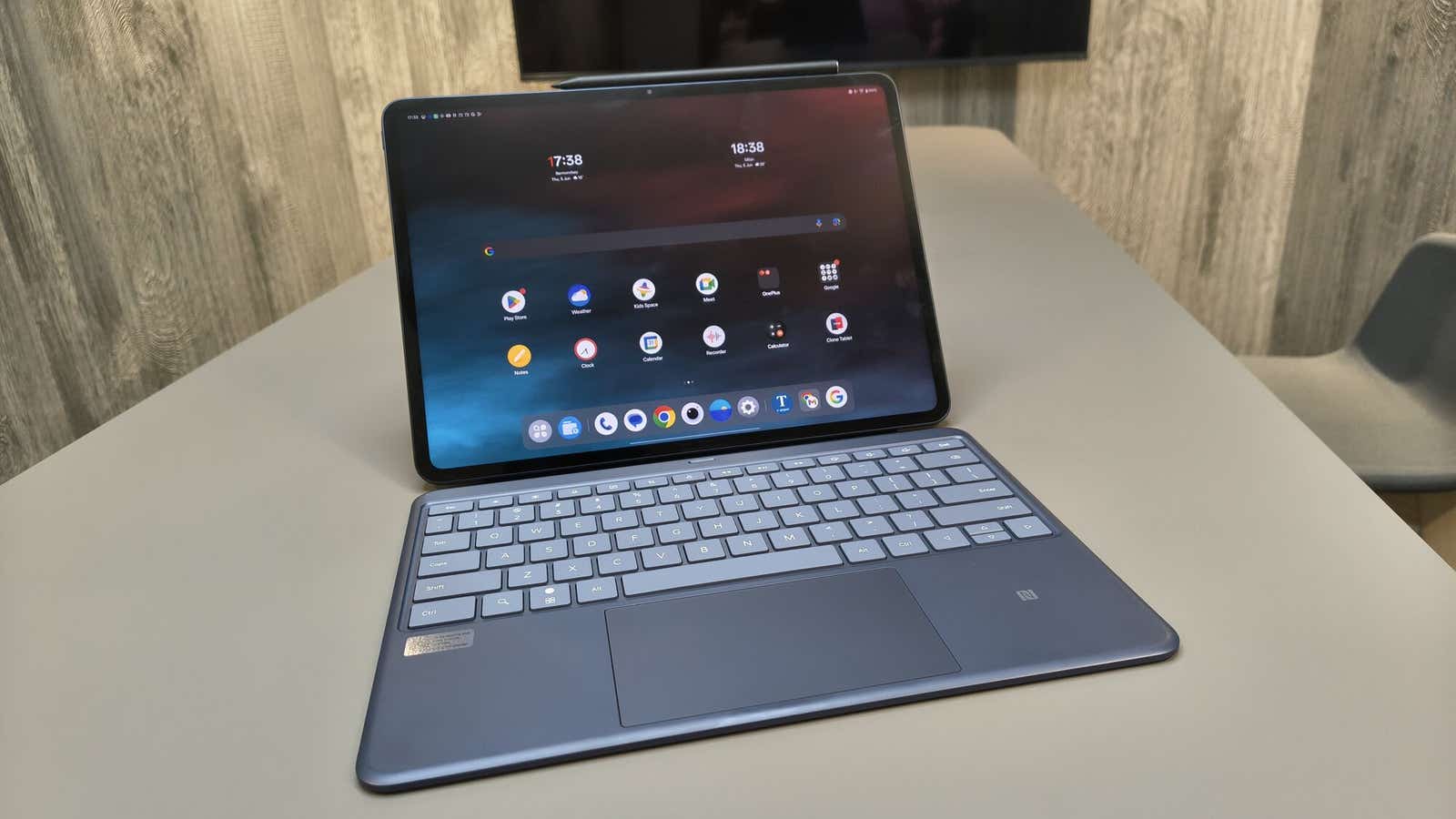OnePlus Pad 3 Review


OnePlus Pad 3 pros and cons
Large, sharp and vibrant 144Hz display.
Premium build is firmly flagship grade, as is the Elite processor.
Accessories add real productivity value.
No built-in mobile connectivity.
Accessories - and additional productivity - come at a cost.
The OnePlus Pad 3 is a clear refinement - as opposed to reinvention - of the Android tablet.
A clear upgrade from the OnePlus Pad 2, this latest effort arrives with a more premium design, sleek set of revised accessories and a noticeably more 'grown-up' software experience.
It still leans into the OnePlus formula of fast, fluid and fuss-free - but now with a professionalism that proclaims it's here to more than make up the numbers.
Let's see if it has what it takes to make three the magic number.

Design and specifications
At under 6 mm thick, the OnePlus Pad 3 is slim, sturdy and seriously refined. It's the thinnest tablet the brand has made to date - but it doesn’t feel delicate.
The aerospace-grade aluminium unibody frame is reassuringly rigid, yet light enough at 675g to stay portable...if slightly more portly than the competition (the 13-inch iPad Pro tips the scales at less than 600g).
On the other hand, it’s decidedly the kind of build quality you’d expect from pricier stablemates, so impressive work here.
OnePlus has certainly tidied things up aesthetically, delivering a device that simply looks - and feels - the part for productivity.
Every line, every curve feels more considered - and subtler - than before. As much as we loved the OnePlus Pad 2, its rounded edges and playful frame give way to a smoother, more deliberate finish.
Transitions between glass and metal more seamless, and there's a confident symmetry from the bezels to the rear which add up to a tablet that gives 'upgrade' vibes from every angle.
The rear camera has migrated from the centre to the upper-right corner, which does wonders for the design’s flow - a small change that makes a big visual difference.
Colour choices have matured too, with Storm Blue being the single colour variant this time, exuding subtlety and polish alike.
This is a tablet that takes itself seriously - and expects you to.

Display and audio quality
The display of the Pad 3 is little short of a triumph.
You’re looking at a 13.2-inch LCD panel with a crisp 3.4K (3392 by 2400) resolution, 12-bit colour depth support and a practical 7:5 aspect ratio.
At 315 ppi it’s pin-sharp, and matching the Pad 2 with a refresh rate topping out at 144 Hz, it means it’s also supremely smooth for scrolling around content.
With 900 nits peak brightness, the Pad 3 stays perfectly legible in just about any indoor environment - and not to shabby on the road either.
Beyond the numbers - it’s the feel of the device that impressed us. Split-screen apps glide, video playback looks lush, and colour gradients stay creamy whether sketching or scrolling.
A Dolby Vision HDR certification leaves no doubt that you have a front-row seat when it comes to streaming your favourite shows.
TÜV Rheinland Eye Care 4.0 certification rounds things off with a nod to comfort during long stints.
Audio is another equally high point.
The eight-speaker array - four tweeters and four woofers flanking the screen - adapt dynamically depending on the orientation of the Pad.
Compared to the Pad 2, you’re getting more depth, more clarity and a noticeably wider soundstage - thanks in no small part to wireless support for Hi-Res audio.
Whether you're binging Netflix or joining a video call, the Pad 3 fills the room with ease.

Camera capabilities
It won’t replace your phone, but the Pad 3 holds its own.
The repositioned 13-megapixel rear camera, is fine for scanning documents and capturing whiteboards, as well as serviceable for taking the occasional snap.
Autofocus helps, and 4K video at 30fps is a decent ceiling.
The 8-megapixel front camera is centred for landscape use - ideal for calls and conferences.
AI extras like background blur and exposure tuning make a subtle difference, helping you stay sharp and well-lit without needing to tweak anything.
As with most features on the OnePlus Pad 3, it's functional rather than flashy...in a good way.

Software and performance
This is the most powerful OnePlus tablet yet - and it certainly walks the talk when put through its paces.
Powered by the Snapdragon 8 Elite Mobile Platform, paired with up to 16 GB of RAM and up to 512 GB of UFS 4.0 storage, the Pad 3 devours everything from gaming to multitasking.
Apps load quickly, transitions are fluid, and even under pressure, the tablet stays cool and consistent thanks to an improved vapor chamber with graphene cooling.
It’s a smooth operator - the kind that doesn’t need to shout about its power, as it's keenly felt through every prod or swipe of the expansive display.
OnePlus' customised OxygenOS 15 comes equipped with tablet-first refinements that make the most of the Pad 3's hardware. It’s slick, intuitive and peppered with genuinely useful features.
Open Canvas has levelled up, with smarter multitasking tools and a split-screen suggestion system that feels more like pushing the limits of productivity than a bullet point.
The AI Toolbox is also in play, offering translation, summarising and writing suggestions. Android underpinnings mean Google Gemini makes a debut as standard, with quick access via the keyboard (sold separately, more on this later) dedicated AI key.
It’s the kind of integration that - once again - makes its intentions clear that its build for more than just media consumption.
That being said, there's still no SIM or eSIM support onboard - but if you’re rocking a OnePlus phone, the Pad 3 can tap into its data automatically, no hotspot faff required.
It’s seamless and once set up, it feels like the tablet has its own dedicated connection in most settings.
When it comes to gaming, the Pad 3 comes prepped - an Adreno 830 GPU and Oryon CPU marry crisp visuals with smooth framerates and make for a great time.
A few races in Asphalt Legends Unite - as well as a couple of cosy hours with Infiniti Nikki - put any concerns around its gaming cred to bed, as battery life took only the smallest of dents.
OnePlus is promising both three major Android version updates and three years of bi-monthly security patches - so the Pad 3 is with you for the long haul. It's a welcome level of commitment which doubles as a real mark of maturity for the Chinese manufacturer.

Battery life and charging
With a 12,140 mAh battery on board, the OnePlus Pad 3 is all about stamina - touted claims of 17 hours of video playback and 6 hours of gaming were more than met in real-world testing, which is no mean feat.
Equally mindful of the way people actually use tablets, a standby time of around a month is entirely welcome, meaning the Pad 3 is ready to go whenever you need it.
When the time finally comes to top up, the 80W SUPERVOOC charger in the box gets you back to full in about 90 minutes, with quick bursts of charge making it enough to keep you going for hours...the OnePlus Pad 3 scores highly in another category where you need it most.
OnePlus Pad 3 accessories
Accessories are where things feel decidedly grown up.
The keyboard has had a proper rethink - bigger keys with improved travel, a smarter layout and that AI shortcut key all make it more comfortable for longer sessions.
Still no backlight is a miss for the night owls amongst us, however. OnePlus says it’s a conscious choice based on feedback and trade-offs, but it’ll be a sticking point for those who prefer to burn the midnight oil.
The Stylo 2 pen is the stylus of choice for the Pad 3 – no need for revision here. It’s accurate, responsive and quick to pair, with 16,000 levels of pressure sensitivity and handy Bluetooth extras. It won’t outdraw an Apple Pencil or Samsung S Pen with the rare bit of hesitance and lag when put through its paces, but for jotting notes or sketching ideas, it absolutely does the job.
The updated folio case is sturdier, with a tri-fold design that supports more angles, and an interlinking mechanism which locks both tablet and stylus securely in place.
All three accessories are sold separately: the Smart Keyboard is priced at £169, the Stylo 2 stylus at £99, and the folio cover case at £59.
Taken together, the accessories round out the Pad 3’s versatility nicely and make it feel like a real productivity setup.

OnePlus Pad 3 UK pricing and availability
The OnePlus Pad 3 is available now for pre-order in the UK at the time of writing, starting at £529 for the 12GB RAM and 256GB storage model.
The higher-specced 16GB + 512GB variant will usually set you back £599, but a launch incentive sees it priced at the same price as the lower model - making for great value from the outset with a £70 saving.
At launch, customers ordering directly from OnePlus.com could choose one accessory - either the Stylo 2 stylus, Smart Keyboard, folio case or a snazzy dual charger - for free, as well as discounted bundles, which sees the capable keyboard available for half price at £84.50.
Add in up to £50 trade-in, and once again OnePlus has a healthy selection of early bird savings.
Even at full price, to get the latest Snapdragon chip with an impressive Adreno GPU for under £600 is not to be sniffed at.

Final verdict
The OnePlus Pad 3 isn’t merely an iterative upgrade - it’s a statement on the power of the tablet form factor for both the consumption and creation of content.
A sharper, more sizeable display, mature design accents, clever suite of accessories and blistering performance all come together to deliver OnePlus’ most complete tablet yet.
A backlit keyboard would have been welcome, and native cellular support remains missing, but everything else is focused, refined and remarkably well-executed - at a competitive price to boot.
This is no longer a plucky contender - it’s a serious option for anyone after a capable tablet - Android or otherwise - with real laptop ambitions.